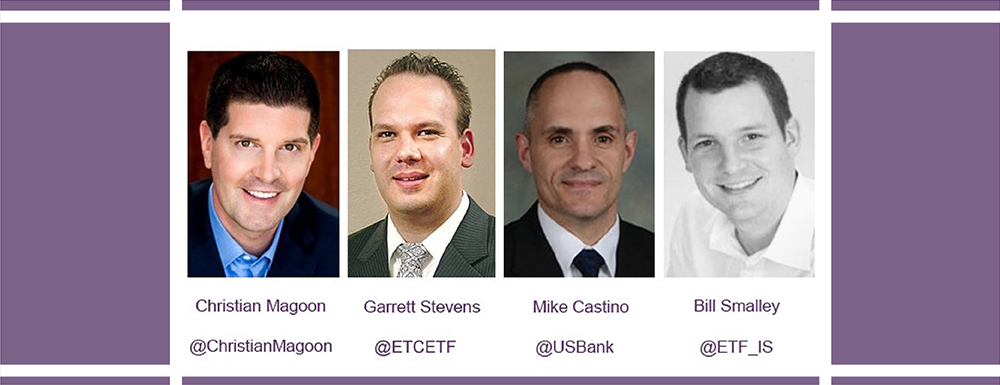In our previous post, we introduced our quartet of ETF industry experts who currently are operating at ground zero of new ETF issuance to talk about how to successfully launch products in an increasingly crowded and competitive market. The four panelists agreed that having a fully-baked approach to marketing and distribution is at the center of a successful launch.
As the industry’s largest conference, ETF.com’s Inside ETFs gets into full swing today, the panel hits on some of the challenges that aspiring ETF issuers face.
Joe:
What is the most overlooked item that is most often involved in a successful ETF launch?
Garrett Stevens:
I think the successful fund launches you see have a very easy story to tell. ROBO is a great example. The ticker and the fund name tell you everything you need to know about the fund. There are lots of great investment ideas out there that are trying to make it in the ETF world but they are so hard to describe and explain that they have a hard time getting traction. I think in many peoples zeal to get their ideas into the market place and to prove how much thought and research went into their products they have trouble keeping the message simple and easily digestible.
William Smalley:
For new entrants, a deep understanding of the demand for a particular new ETF within the channels accessible to the issuer early in the process has been a deficiency from which new participants have suffered in recent years.
Christian Magoon:
One of the most overlooked items for an ETF launch is the turnaround times needed by various service providers. Just because an ETF is launched doesn’t mean that service providers can or will be able to expedite their normal turnaround times. Often, ETF sponsors who have just launched a product want everything done immediately, but that is seldom how it works. Proper planning ahead of time can identify and ease some burdens when it comes to this commonly overlooked item.
Mike Castino:
The most overlooked item in a success ETF launch is identifying sources of AUM. Every ETF is launched under the premise of providing access to an innovative or compelling strategy. However, we have seen many ETFs with great track records close over the years; many times not for lack of performance but for lack of AUM growth. Without significant AUM in an ETF it may be a tough conversation to convince investors to be “first in” and product approval committees to approve the ETF for use on their platform.
Joe:
Has the continued launch of new ETF/ETP products made it easier or harder for issuers to gain marketplace acceptance of their product?
Mike Castino:
The continued launch of both passive and active ETFs has made acceptance of ETFs easier. Continued demand has fostered innovation and efficiency with issuers, service providers, and the SEC. Streamlined application processes and increased familiarity with product structures, securities utilized within portfolios, and management techniques have shortened the application/approval/launch process. This includes the 19b-4 application process exchanges must go through prior to listing certain products. Clarity in terms of what is “getting through” the process and what is not is essential intelligence.
Just as important is the continued advancement and efficiency in the ETF capital markets arena. Agency execution desks are providing crucial services in the areas of liquidity sourcing and best execution. Authorized Participants continue to streamline and provide creation/redemption efficiency. Lead market makers/designated liquidity providers and secondary liquidity providers continue to keep bid/ask spreads tighter and depth of book more robust. Product sponsors and institutional investors should always engage these capital markets players for their benefit and the benefit of their clients.
Christian Magoon:
Yes, it is harder than ever to launch a new ETF due to an increased amount of products and sponsors. For this reason, people and firms with a track record of successful ETF launches are crucial to align with. A successful ETF launch has the potential to result in an instantly profitable fund that will also generate significant brand awareness. Conversely, an unsuccessful ETF launch almost guarantees hundreds of thousands of dollars in future fund subsidy costs, elevates the risk of product closure and could diminish the sponsor’s reputation.
William Smalley:
On the one hand, there are nearly 1,700 U.S. ETPs, so shelf space is perpetually growing tighter. On the other, ETF AUM continues to grow at an astonishing pace (especially relative to mutual fund growth). This dynamic is one of the reasons why we are bullish on active and alternative ETFs. As you know, most ETFs today have low cost Beta objectives. There remains tremendous opportunity in the marketplace for new and unique products, particularly in asset classes and strategies dominated by mutual funds and/or hedge funds. We firmly believe we are in the early innings of the ETF game, and we welcome the competition for market share. It’s never easy, but barriers are falling even as more asset managers enter the business.
Garrett Stevens:
I think it’s made it easier. People are used to seeing and hearing about ETFs. There is less explanation that has to go on about the vehicle itself before you even get to the funds strategy than there used to be. The popularity and the prevalence of the ETF wrapper is helping to inform people and give them comfort that ETFs are not esoteric, derivative type investments that they should stay away from.
For some more tips on launching an ETF, check out ThinkAdvisors’ recent article, So You Want to Launch Your Own ETF?
